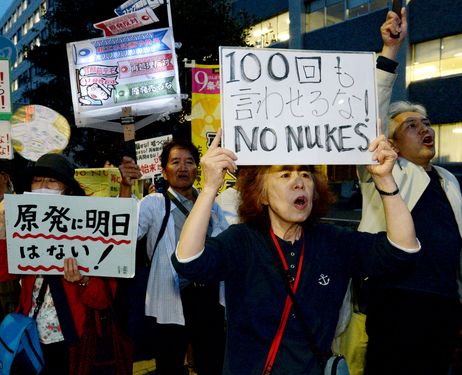May 04, 2014
Mundo Sustentável

100th anti-nuclear protest held in Tokyo, but with far fewer people
100th anti-nuclear protest held in Tokyo, but with far fewer people

Keiko Kato, a regular participant in Friday night anti-nuclear protests in Tokyo, holds a sign reading “Don’t make us say this 100 times” on May 2. It was the 100th such protest in front of the prime minister’s office in Tokyo’s Chiyoda Ward. (Satoru Ogawa)
Anti-nuclear demonstrators held their 100th rally in Tokyo on May 2 amid concerns over the dwindling number of participants at the Friday night fixture in front of the prime minister’s office.
The citizens groups behind the protests wonder how they can mobilize the “silent majority” to sustain the movement. However, some say the shrinking attendance has strengthened participants’ spirit and sense of commitment to protect the “beacon of hope.”
At 6 p.m. before sunset on May 2, people hoisting banners calling for nuclear-free Japan stood in neat rows along the sidewalk leading to the prime minister’s office in Chiyoda Ward. They started chanting “we oppose nuclear resumption.”
Organized by the Metropolitan Coalition Against Nukes, the demonstration targeted moves to restart two reactors at the Sendai nuclear power plant in Kagoshima Prefecture. The Nuclear Regulation Authority is in the final stage of safety screenings at the plant, operated by Kyushu Electric Power Co.
Keiko Kato, a 68-year-old translator from Kawasaki, raised a handwritten sign that read: “No nukes: Don’t make us say this 100 times!”
It was her 93rd Friday night protest.
“I will attend this protest until all reactors become decommissioned so that we won’t hand over this ill legacy to future generations,” Kato said.
The Metropolitan Coalition Against Nukes, which comprises 11 citizens groups and individual supporters, said about 3,000 people participated in the 100th protest, three times more than the average draw.
The first Friday night demonstration was held on March 29, 2012, a year after the Fukushima nuclear disaster unfolded.
It soon became a weekly event in front of the prime minister’s office because the location and demonstration hours were convenient for those who work during the daytime and homemakers.
In its heyday in June 2012, the rally drew as many as 200,000 people on one night.
Saiko Yokozeki, a 44-year-old high school teacher from Tokyo’s Shinjuku Ward, participated in the May 2 rally with her three children. The family has joined in the event around 10 times over the past two years, and Yokozeki has noticed that the number of participants is shrinking.
“We are becoming desensitized to and less and less interested in the reality of Fukushima, although the plant is still emitting radiation-contaminated water every day,” she said. “Someone must keep standing here to raise voices of opposition (to nuclear power).”
Norimichi Hattori, a 38-year-old corporate worker from Tokyo’s Edogawa Ward, said he has regularly attended the rally since its early days to remind himself to never forget about Fukushima.
“In fact, the protest still attracts first-time participants,” he said.
The rallies in the center of the nation’s capital have spurred similar movements across Japan. More than 40 citizens groups nationwide stage Friday night protests in their hometowns.
Tetsu Iwai, a 67-year-old leader of an anti-nuclear group in Kagoshima that has held Friday demonstrations against the resumption of the Sendai plant, said the Tokyo rallies have served as a morale booster for movements across Japan.
“The people who are holding on in Tokyo have sent us a lot of emotional support,” Iwai said.
Eiji Oguma, a professor of historical sociology at Keio University who has participated in the Tokyo rallies, said it is critically important for the protest in this form to continue because “it can visualize public opinion and serve as a flag to lead the people.”
“Because there is much public support for the abolishment of nuclear power, movements such as this can eventually affect the course of the country,” he said.
Popular writer Kaoru Takamura attributed the declining numbers at the Tokyo protests to the pro-nuclear government’s policy of preventing the nuclear issue from becoming a focal point of national debate.
“Politicians have tried to prevent national debate on the nuclear issue and the problem surrounding nuclear energy from surfacing. It is against this background that people’s urgent sense of alarm over nuclear power is clouded by their busy daily lives,” Takamura said.
“It could simply be arrogance if politicians assume that the declining number of protesters signals a diminishing sense of rejection of nuclear power among the general public.”
loading...
- China Prevê Que Medidas Anti-tabaco
China prevê que medidas anti-tabaco evitarão 13 milhões de mortes até 2050http://www.em.com.br/app/noticia/internacional/2014/02/19/interna_internacional,499861/china-medidas-anti-tabaco-evitarao-13-milhoes-de-mortes-ate-2050.shtml AFP - Agence...
- Hallogreen
Monday, November 14, 2011Volume XXVI, Number 5530 Photo by Daniel Avila Parks Celebrates A Happy And Sustainable ‘Hallogreen’On Friday, October 28, the Arsenal celebrated its first annual HalloGreen energy awareness and sustainability event. The...
- Japão Reativa Reator Nuclear...mas é O Risco?
17/08/2011 - 06h00Japão reativa primeiro reator nuclear desde vazamento em Fukushimahttp://www1.folha.uol.com.br/mundo/960891-japao-reativa-primeiro-reator-nuclear-desde-vazamento-em-fukushima.shtml DAS AGÊNCIAS DE NOTÍCIAS O governo...
- No Japão, 74% Defendem Fim Gradual Da Energia Nuclear... Caso Sobrevivam.
No Japão, 74% defendem fim gradual da energia nuclearOposição a reatores foi maior em províncias que abrigam complexos nucleares14 de junho de 2011 | 7h 35 http://www.estadao.com.br/noticias/internacional,no-japao-74-defendem-fim-gradual-da-energia-nuclear,732070,0.htm...
- Inacreditável: Brasil Ainda Planeja Construir Entre 4 E 6 Novas Usinas Nucleares Até 2030! A Eletronuclear Deveria Abrir Uma Filial Em Fukushima!
Brasil planeja entre 4 e 6 novas usinas nucleares até 2030 Autoria: Júlia Dias Carneiro - BBC - 26/04/2011 SITE INOVAÇÃO TECNOLÓGICA. Brasil planeja entre 4 e 6 novas usinas nucleares até 2030. 26/04/2011. Online. Disponível em www.inovacaotecnologica.com.br/noticias/noticia.php?artigo=brasil-planeja-novas-usinas-nucleares....
